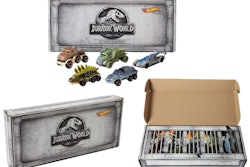According to a recent Harvard Business Review article, the death of supply chain management will occur in the next 5-10 years, making the warehouse an obsolete function replaced by self-regulating, autonomous technology.
Kristi Montgomery, VP of Innovation at KENCO Group, mentioned this article when presenting at the WERC Annual Conference for Logistics Professionals on Monday in Columbus, OH. She also said that according to Forbes, 65% of supply chain leaders believe we are experiencing an industry tectonic shift, and asked how prepared attendees were for this disruption.
Montgomery, who is optimistic that supply chain management has a longer life-span than 10 years, said innovation is a hot topic in the supply chain industry right now. Some of the market demands driving innovation include the labor market and capacity constraints. According to Montgomery, logistics jobs were up 219,000 last year with not enough labor to fill them. Many warehouses are filled to capacity, or overfilled. And with consumers expecting on-demand service, or with other demands such as cost pressure in a market that doesn’t see high margins, innovation is necessary to progress.
Another hot topic is e-commerce. Kenco performed a study of 15,000 supply chain professionals, and found 73% of respondents say e-commerce is a priority in their organization, but more than half are only budgeting 10% or less of their overall budget toward implementing e-commerce operations. Montgomery said that uncertainty of where and how to invest in e-commerce is an issue, and that more companies in the supply chain are investing to meet retail compliance.
Kenco survey respondents also said that adoption of emerging technologies such as IoT and robotics in the supply chain have increased slightly, up 5% from last year. The end goal of these investments is to improve processes and “do things better.” Said Montgomery, “Innovation is the catalyst to create higher yield process improvements.” And improved processes mean increased profitability.
When asked which technologies they think will have delivered the most supply chain innovation benefits in the next 5 years, respondents felt that mobile devices and apps, data analytics and warehouse automation robots were the leading categories. AI/machine learning, IoT and driverless trucks were of lesser importance, while blockchain, drones and 3D printing lagged at the bottom.
The technologies such as IoT, robots, 3D printing, blockchain and AI are seen at this point as experimental, with small scale implementation in a test phase, and scaling up of operations after figuring out where and how technologies work best.
Another topic Montgomery addressed is supply chain digitization. How are we changing the supply chain to be more digitally focused, and therefore better serve our consumers “better, faster, cheaper?” Tech only works when integrated with re-vamping operations, said Montgomery, and we must understand the problem we are trying to solve first, then consider the technology that can help that problem.
One strategy Montgomery encourages is figuring out how to commercialize data. She said supply chain companies need to find a way to monetize data, and the insights that can be drawn from it. The hurdle to accomplish that is to collaborate and integrate with others in a “collaborative ecosystem” that allows circular, real-time on-demand data.
Montgomery said there have been studies that show companies that aggressively digitize their supply chain can boost their annual economic growth by over 3%, and top-line revenue by at least 2%. Digitizing will also boost the customer experience, by allowing the customer to see what they want, when they want, and to make changes along the way.
Other benefits of moving to a smart, connected warehouse:
- Faster lead times
- More reliable service
- Higher degree of process efficiency
- Elevated visibility
- Proactive vs. reactive
- Better collaboration
- Workflow optimization
How to begin? Montgomery listed the following as some of steps to start moving to a smart, connected warehouse:
- Align with overall business strategy
- Rethink current business models
- Strengthen core differentiators – what are we already doing well?
- Take an integrated, cross functional view – collaborate with other departments
- Determine how you will manage the change and communicate to your team
Montgomery said the most important takeaway is this: companies that want to innovate supply chain must figure out how to change the company culture. The entire organization must have a mindset of innovation, being more creative, and serving the customer through innovation.
One suggestion to achieve this goal is to ask employees, particularly people on the floor, what needs to change, and reward them (with recognition) for providing ideas. Companies must also be willing to let employees fail, and to allow them to tell management they have failed without punishment. Montgomery said it’s OK to fail if you learn from the mistake – how to do it better next time. Other tips? Watch what your rivals are doing. Think big but start small – the incremental wins add up. Be agile and willing to change quickly.
Montgomery closed by citing the following example: on Monday, Kodak stocks were at $2.45 and Fujifilm was at $46.25. When digital camera technology came out, Eastman Kodak – who created the first digital camera - said they didn’t need digital technology. But Fujifilm saw it as an industry disruptor, so they figured out how to pull the collagen from their film and monetize it to the bio-medical industry, showing agility and innovation that has clearly paid off.
“Are you one of the Kodaks, or are you one of the Fujifilms?” asked Montgomery.
To learn more about WERC, click here.
Learn more about supply chain solutions at PACK EXPO Las Vegas, September 23-25.


























